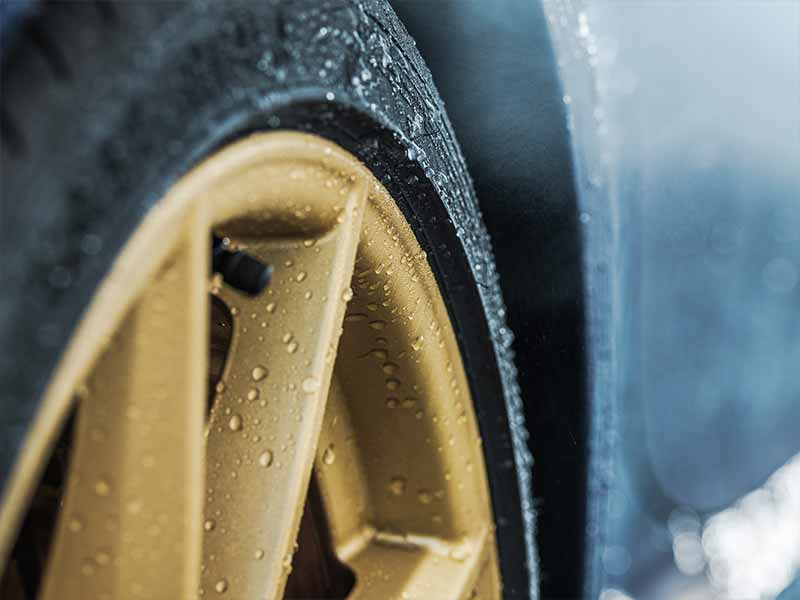Did you know that the right tire traction rating can significantly impact your vehicle’s safety and performance? With so many options available, choosing the perfect tire can feel like a daunting task. But don’t worry, we’ve got you covered.
What Is A Good Tire Traction Rating?
A good tire traction rating to consider is “A”. The vast majority of tires manufactured today fall into this category and there aren’t many reasons to go with anything less.
“AA” ratings are great for performance vehicles that demand exceptional traction, but wear faster and cost more for benefits that the average consumer wouldn’t appreciate for the trade off.
In this article, we’ll dive into the world of UTQG ratings for traction, from AA to C, and help you understand their importance.
Let’s take a closer look.
What Do Traction Ratings On Tires Mean?
Tire traction ratings are like a report card for your tires, providing a clear and simple way to understand their performance. They tell you how well your tires can grip the road, particularly when it’s wet or slippery. Good traction is crucial for keeping your car on the road and ensuring it responds well when you steer, brake, or accelerate. Let’s dive deeper into the world of traction ratings.
The Testing Process
To determine a tire’s traction rating, manufacturers put their products through a series of tests. The most important one is the “traction test,” which evaluates the tire’s performance on wet surfaces. During this test, tires are fitted onto a special testing vehicle and driven over a wet surface at a controlled speed. The vehicle’s braking and acceleration are carefully measured to see how well the tires grip the road.
The Rating System
Based on the traction test results, tires are assigned a letter grade – AA, A, B, or C – to indicate their level of traction. Here’s a quick breakdown of what each grade means:
- AA: These tires offer the best possible traction, making them great for areas with lots of rain or wet conditions.
- A: A-rated tires provide excellent traction, but they might not perform quite as well as AA-rated ones in extremely wet conditions.
- B: Tires with a B rating offer good traction but may not be the best choice for areas with frequent heavy rain.
- C: C-rated tires provide the minimum acceptable level of traction, and they might not be suitable for driving in wet or slippery conditions.
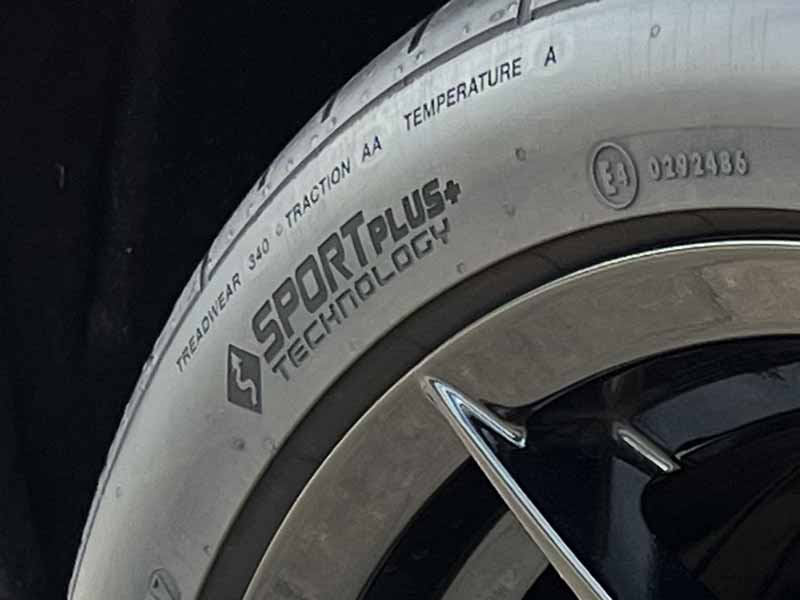
Beyond Wet Traction
While the traction rating mainly focuses on wet conditions, it can also give you a general idea of how a tire will perform on dry surfaces. Tires with higher traction ratings usually have better grip on dry roads as well, but it’s essential to keep in mind that traction isn’t the only factor affecting a tire’s overall performance. Other factors like tread pattern, rubber compound, and tire structure also play a significant role.
Considering Your Driving Conditions
When choosing a tire, it’s essential to think about the conditions you’ll be driving in most often. If you live in an area with frequent rain, snow, or ice, you should consider tires with a higher traction rating (AA or A). On the other hand, if you live in a drier climate, B or C-rated tires may be sufficient for your needs.
UTQG Traction Rating Chart
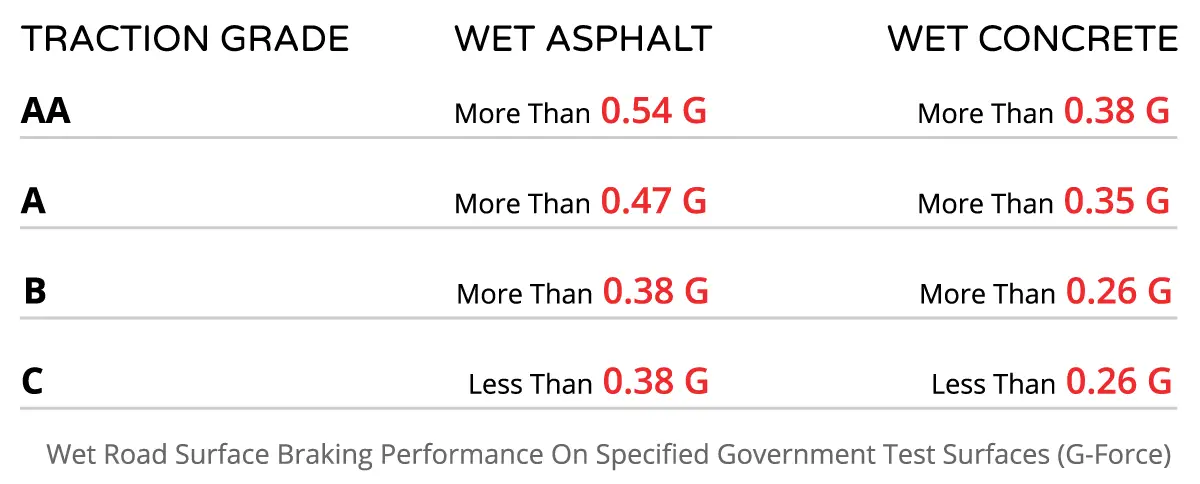
Tire Traction Rating AA Vs A
When it comes to tire traction ratings, AA and A represent the top performers. Both offer excellent grip on wet and slippery roads, ensuring a safer and more reliable driving experience.
The Difference In Performance
AA-rated tires are the cream of the crop, offering the highest level of traction available. These tires are designed with advanced rubber compounds and tread patterns, providing superior grip on wet roads.
A-rated tires, while still providing excellent traction, may not perform quite as well as their AA counterparts in extremely wet or slippery conditions.
Dry Road Performance
While traction ratings mainly focus on wet conditions, they can also give you an idea of a tire’s performance on dry roads. Both AA and A-rated tires usually provide great grip and handling on dry surfaces, but AA-rated tires might have a slight edge due to their advanced design and materials.

Tire Traction Rating A Vs B
Tire traction ratings A and B both indicate good performance on wet and slippery roads, but there are some key differences between the two.
The Difference In Performance
A-rated tires offer excellent traction on wet roads, thanks to their high-quality rubber compounds and tread patterns. B-rated tires, on the other hand, provide good traction but may not perform as well as A-rated tires in very wet or slippery conditions.
The age of this test shows since it is fairly rare to find a tire that only manages to score a B traction grade. Due to this fact you should be able to find a tire meeting your needs with at least a traction grade of A.
Dry Road Performance
While traction ratings primarily focus on wet conditions, they can also give you an idea of a tire’s performance on dry roads. Both A and B-rated tires generally provide good grip and handling on dry surfaces, but A-rated tires may have a slight edge due to their advanced design and materials.
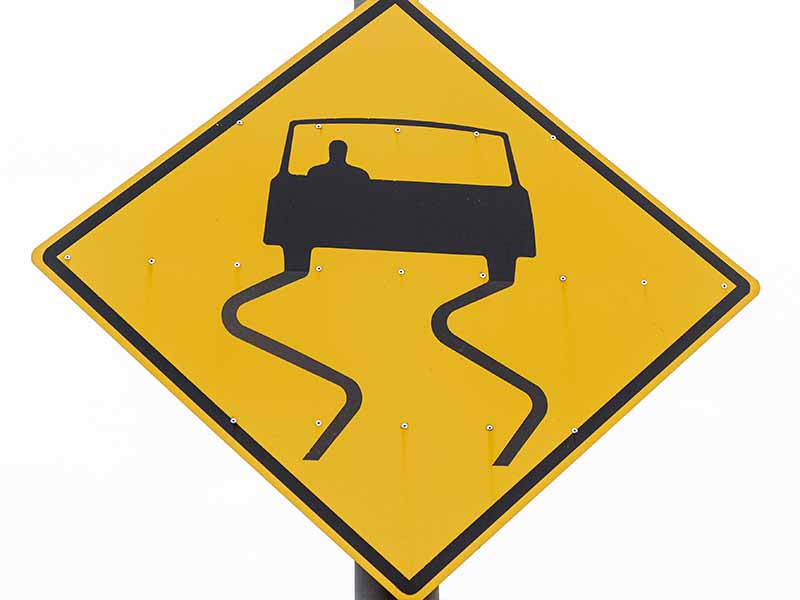
Tire Traction Rating B Vs C
Tire traction ratings B and C represent the lower end of the scale in terms of wet road performance. While both types of tires meet the minimum traction requirements, there are notable differences between the two.
The Difference In Performance
B-rated tires offer good traction on wet roads due to their rubber compounds and tread patterns, but they may not perform as well as A or AA-rated tires in very wet or slippery conditions.
C-rated tires, on the other hand, provide the minimum acceptable level of traction, making them less suitable for driving in wet or slippery conditions compared to B-rated tires.
Dry Road Performance
While traction ratings primarily focus on wet conditions, they can also give you an idea of a tire’s performance on dry roads. Both B and C-rated tires generally provide adequate grip and handling on dry surfaces, but B-rated tires may have a slight edge due to their more advanced design and materials.
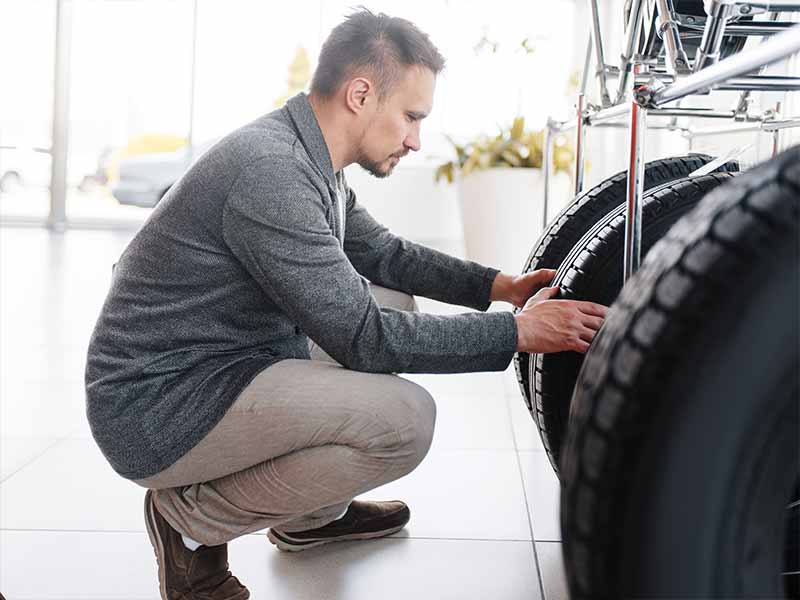
Choosing the Right Tire Traction Rating for Your Needs
Selecting the right tire traction rating for your vehicle is crucial to ensure optimal safety, performance, and value. In this section, we’ll discuss the factors you should consider when choosing a tire traction rating, including driving habits and environment, matching tire ratings to vehicle requirements, and balancing performance, safety, and budget.
Consideration of Driving Habits and Environment
- Local Climate: Consider the typical weather conditions in your area when choosing a tire traction rating. If you live in a region with frequent rain or wet roads, it’s wise to invest in tires with a higher traction rating like AA or A. On the other hand, if your area has little rain or dry conditions, B or C-rated tires might be suitable.
- Driving Conditions: Think about the type of roads you usually drive on and the challenges you encounter. For example, if you regularly drive on highways with high-speed traffic, you may want to choose tires with a higher traction rating for better grip and control. Similarly, if you frequently navigate winding roads or steep inclines, enhanced traction can provide added stability and safety.
Matching Tire Ratings to Vehicle Requirements
- Vehicle Specifications: It’s essential to consult your vehicle’s owner’s manual or manufacturer recommendations when choosing a tire traction rating. The manufacturer has designed your vehicle with specific performance and safety characteristics in mind, and selecting the appropriate tire rating will ensure the best possible performance.
- Tire Load Capacity and Speed Rating: In addition to the traction rating, it’s crucial to consider the tire’s load capacity and speed rating, which indicate the tire’s ability to carry a specific weight and maintain safe performance at high speeds. Always choose tires that meet or exceed your vehicle’s requirements to ensure optimal safety and performance.
Balancing Performance, Safety, and Budget
- Prioritize Safety: While it’s essential to consider your budget when choosing a tire traction rating, prioritize safety above all. Investing in higher-rated tires can offer superior grip and control in wet or slippery conditions, which can ultimately help prevent accidents and protect you and your passengers.
- Assess Longevity and Fuel Efficiency: When balancing performance, safety, and budget, consider the tire’s expected lifespan and potential impact on fuel efficiency. Higher-rated tires may offer better performance but could have a shorter lifespan or slightly lower fuel efficiency. Evaluate the trade-offs based on your driving habits and environment.
- Shop Around: Lastly, it’s always a good idea to shop around and compare prices from different tire retailers. You might find great deals on higher-rated tires, making it more cost-effective to invest in better traction without exceeding your budget.
Resources
Below are some links you may find helpful when learning about tires
- Everything you need to know about UTQG ratings – Cooper Tires
- What are the uniform tire quality grade standards – TireRack.com
Final Thoughts
From AA-rated tires with superior wet road performance to C-rated tires that meet the minimum requirements, each rating offers different levels of traction to suit various driving conditions and preferences.
The bottom line is that almost everyone should stick to a traction rating of A. AA traction tires perform great for sports cars but will cost more, wear more quickly, and simply aren’t necessary. Stay away from tires sold with B or C traction grades unless you need them for a specific reason that makes sense.
Good luck and happy motoring.
